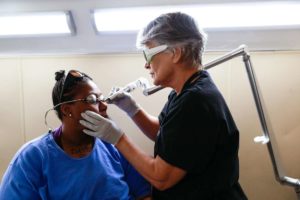Erasing mistakes: California helps inmates remove tattoos

In her fourth session to remove tattoos that she had inked on her cheeks behind bars, Jessica Garcia has asked the technician to crank up the intensity.
“Ooh, I can smell it. Can you smell it?” she says. An expression of utter tranquility belies any discomfort.
Garcia wears bulbous goggles to protect her eyes from the red flashes. If not for the prison uniform, she could be about to slip into a tanning bed. As the ruby beam clicks into action, she grips her chair and inadvertently kicks the wall.
Garcia, 24, and dozens of other inmates are burning off tattoos they no longer want — and in some cases, never did — during bimonthly visits aboard a converted bus parked in the front yard of the Folsom Women’s Facility.
The California Prison Industry Authority, a state agency that provides work placement and job training for inmates, started the program in May 2018 after former convicts said their tattoos were a barrier to finding a job on the outside.
So far, 216 women, with about 650 tattoos, have been treated at the prison in Folsom. An additional 57 women, with about 160 tattoos, have participated through a community re-entry program in Sacramento.
It’s a mentally and emotionally transformative experience for participants, many of whom are removing gang tattoos or branding that they received when they were trafficked as sex workers.
“They can get rid of the old scars or signs that may have brought them to prison,” says Michele Kane, a spokeswoman for the authority. “It’s like a release.”
Officials plan to expand the program to nearly two dozen additional lockups next year, bringing laser treatments to male inmates for the first time. The state budget includes a $1.1 million funding boost that the Department of Corrections and Rehabilitation estimates will allow the tattoo removal program to reach 3,000 more prisoners a year. Read more >>>